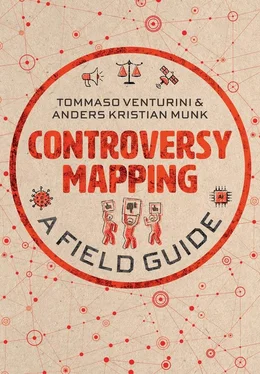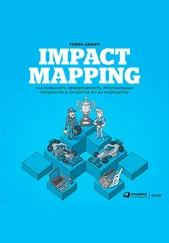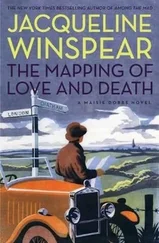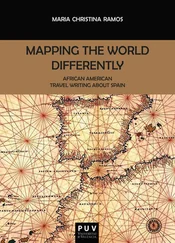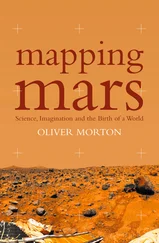Tommaso Venturini - Controversy Mapping
Здесь есть возможность читать онлайн «Tommaso Venturini - Controversy Mapping» — ознакомительный отрывок электронной книги совершенно бесплатно, а после прочтения отрывка купить полную версию. В некоторых случаях можно слушать аудио, скачать через торрент в формате fb2 и присутствует краткое содержание. Жанр: unrecognised, на английском языке. Описание произведения, (предисловие) а так же отзывы посетителей доступны на портале библиотеки ЛибКат.
- Название:Controversy Mapping
- Автор:
- Жанр:
- Год:неизвестен
- ISBN:нет данных
- Рейтинг книги:4 / 5. Голосов: 1
-
Избранное:Добавить в избранное
- Отзывы:
-
Ваша оценка:
- 80
- 1
- 2
- 3
- 4
- 5
Controversy Mapping: краткое содержание, описание и аннотация
Предлагаем к чтению аннотацию, описание, краткое содержание или предисловие (зависит от того, что написал сам автор книги «Controversy Mapping»). Если вы не нашли необходимую информацию о книге — напишите в комментариях, мы постараемся отыскать её.
Controversy Mapping A crucial field guide and hands-on companion for the digital age,
is an indispensable resource for students and scholars of media and communication, as well as activists, journalists, citizens, and decision makers.
Controversy Mapping — читать онлайн ознакомительный отрывок
Ниже представлен текст книги, разбитый по страницам. Система сохранения места последней прочитанной страницы, позволяет с удобством читать онлайн бесплатно книгу «Controversy Mapping», без необходимости каждый раз заново искать на чём Вы остановились. Поставьте закладку, и сможете в любой момент перейти на страницу, на которой закончили чтение.
Интервал:
Закладка:
Controversy mapping has existed as a pedagogic practice in Science and Technology Studies (STS) since the early 1990s, and Bruno Latour has played a pivotal role all the way from its inception at a time when mapping projects were still handed in on paper through to its later digital adaptations. He is also the reason why the authors of this book first met and we can safely say that it would not have been written without him. We first got in touch more than a decade ago while working at different ends of Bruno’s MACOSPOL project (MApping COntroversies in Science for POLitics – the first large-scale research project dedicated to the approach). Anders was teaching controversy mapping on the MSc program in Nature, Society, and Environmental Politics at the University of Oxford, which was one of five test beds, while Tommaso was working on the digital part of the project and himself teaching controversy mapping at SciencesPo (the three remaining test beds were MIT, the EPFL – École Polytechnique Fédérale de Lausanne, and the École des Mines). From that early collaboration we were able to take inspiration from the vanguard of controversy analysis in STS, including Andrew Barry, Sarah Whatmore, Valerie November, Albena Yaneva, who went on to write the first book on controversy mapping in architecture (Yaneva, 2011), and not least Noortje Marres, who was already a leading figure in digital methods and has since published a seminal book on digital sociology (Marres, 2017) and established one of the key research groups in the field at the University of Warwick.
Noortje’s role is particularly interesting because she embodies the crosspollination that went on in the early 2000s between Richard Rogers and his Digital Methods Initiative (DMI) in Amsterdam, and Bruno Latour and his STS group in Paris. As a doctoral student in both places, her work was the first real example of what could happen at the interface between actor-network theory and new digital methods for studying issues online. As junior researchers at the time, we took inspiration from her example. Indeed, digital methods would be as impossible to imagine without Richard and Noortje as controversy mapping would be without Bruno. Richard’s books on digital methods are already classics (Rogers, 2013a, 2019). The summer and winter schools convened by his team in Amsterdam (Esther Weltevrede, Liliana Bounegru, Natalia Sanchez Querubin, Carolin Gerlitz, Anne Helmond, Fernando van der Vlist, Sabine Niederer, Marc Tuters, to name a few) have become the go-to place for a generation of young social cartographers. Arguably, the game-changing role of the DMI came about through its early focus on toolmaking. Building research instruments to repurpose digital records and reflecting on the implication of such an operation, people like Erik Borra and Bernhard Rieder have enabled controversy mappers to develop their craft in critical proximity to its more technical sides. This cannot be acknowledged enough and deserves far more credit than is typically allotted.
A similar story can be told about the Sciences Po médialab which was, when we first met, coming into its own as a hub for digital methods toolmaking. Bruno had made it a precondition for his move from the École des Mines to Sciences Po Paris that he could set up a lab with research engineers capable of developing new tools for quali-quantitative research. Many of these engineers came from Franck Ghitalla’s group at the University of Compiègne and brought with them a focus on visual network analysis. Mathieu Jacomy, in particular, has become a very close collaborator and an invaluable sparring partner for both of us. He was also the initiator of the Gephi software which has become synonymous with visual network exploration for everyone in digital methods and quite a few people beyond. In general, the importance of the médialab for our formation as controversy mappers cannot be overstated, to a large extent thanks to the unique atmosphere created by and around toolmakers like Paul Girard, Benjamin Ooghe-Tabanou, Daniele Guido, Guillaume Plique, Alexis Jacomy, Audrey Banneyx, and Jean-Philippe Cointet.
After MACOSPOL came a period of expansion. Anders went back to Copenhagen to set up the first Danish controversy mapping course with Torben Elgaard Jensen at the Danish Technical University. That same year, in 2010, Anders Blok, Martin Skrydstrup, and Ayo Wahlberg started a similar course at the University of Copenhagen, followed a couple of years later by a course at the Danish IT University run by Britt Ross Winthereik and Michael Hockenhull, and a course in Aarhus run by Peter Danholt and Kristian Hvidtfelt Nielsen. There was now a basis for a local Danish research environment centered around controversy mapping teaching, which resulted in the now obsolete server community Copenhagen Association for Digital Methods. We were both involved, together with Torben Elgaard Jensen and Mathieu Jacomy, when Mark Elam and Åsa Mäkitalo began an ambitious project to teach STS through controversy mapping in high schools in Gothenburg. A similar idea was pursued by the FORCCAST project under the direction of Dominique Boullier, and later of Nicolas Benvegnu and Thomas Tari, in collaboration with researchers from the École nationale supérieure des Arts Décoratifs, the École de Mines, Télécom ParisTech and the Institutes of Complex Systems of the Île de France and Rhône-Alpes regions. In the same years, Tommaso was giving seminars on controversy mapping at the Politecnico di Milano and at the Universidade Federal do Rio de Janeiro with Fernanda Bruno and the team at her lab. As the network grew larger, so did the sense that we needed to write a book.
At the médialab, Tommaso had been working with Axel Meunier to develop the successor project to MACOSPOL. When EMAPS (Electronic Maps to Assist Public Science) received funding, it was an opportunity to not only teach controversy mapping but also to develop it as a proper research method and assess its ability to make a difference in the world beyond the classroom. Anders moved to Paris and for two years we were both working with Axel and many of the people mentioned above to show that we could map the controversy on climate adaptation in ways that actually mattered to its protagonists. EMAPS foregrounded the key role of data visualization in controversy mapping projects and cemented a burgeoning collaboration with the information designers at the Density Design lab in Milan. Today, it would be hard to imagine controversy mapping without a strong visual component and the contributions of people like Donato Ricci, Daniele Guido, Michele Mauri, Angeles Briones, Paolo Ciuccarelli, and their many dedicated students. Indeed, Federica Bardelli, to whom we owe immense gratitude as the designer of the illustrations in this book, is herself a product of Density Design and embodies the difference that the Milan crowd continues to make to the practice of controversy mapping.
When EMAPS ended in 2015, many of us took up new positions. Tommaso went first to the Digital Humanities Department of King’s College London to work with Tobias Blanke, Marc Coté, and Jennifer Pybus, and then to Lyon to collaborate with Pablo Jensen and further develop the technique of visual network analysis. Anders went back to Copenhagen to establish the Techno-Anthropology Lab together with Anders Koed Madsen, Andreas Birkbak, Torben Elgaard Jensen, and Morten Krogh Petersen. The group there, which was later joined by Mathieu Jacomy, Mette Simonsen Abildgaard, and Asger Gehrt Olesen, has provided an intellectual home base for much of the writing process. Together with the prodigious organizational talents of Jonathan Gray and Liliana Bounegru, Tommaso devised the concept for the Public Data Lab which now convenes much of the old EMAPS group and a whole bunch of great new acquaintances in a fantastically engaging and interest-driven network, the activities of which have been another key intellectual anchor point and a place to spar on drafts and ideas throughout the past five years.
Читать дальшеИнтервал:
Закладка:
Похожие книги на «Controversy Mapping»
Представляем Вашему вниманию похожие книги на «Controversy Mapping» списком для выбора. Мы отобрали схожую по названию и смыслу литературу в надежде предоставить читателям больше вариантов отыскать новые, интересные, ещё непрочитанные произведения.
Обсуждение, отзывы о книге «Controversy Mapping» и просто собственные мнения читателей. Оставьте ваши комментарии, напишите, что Вы думаете о произведении, его смысле или главных героях. Укажите что конкретно понравилось, а что нет, и почему Вы так считаете.
